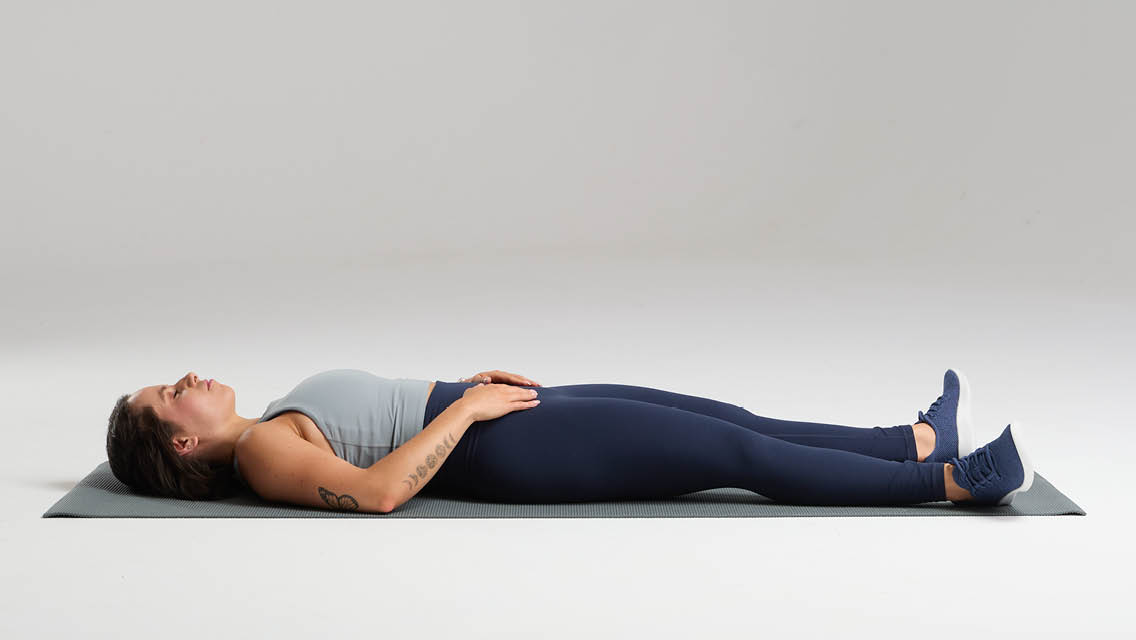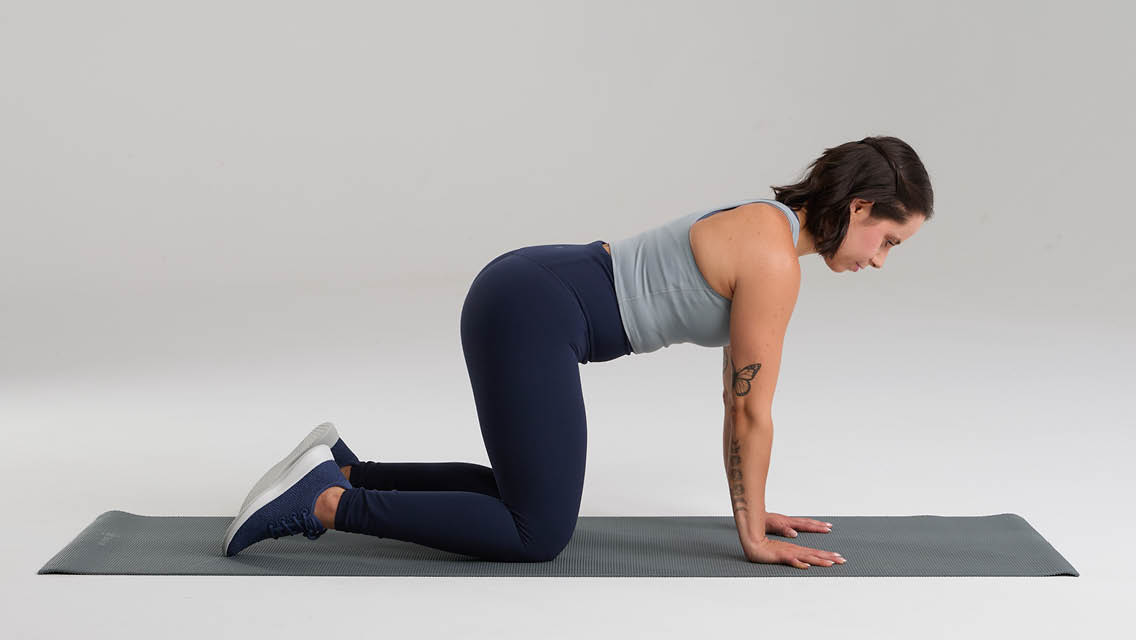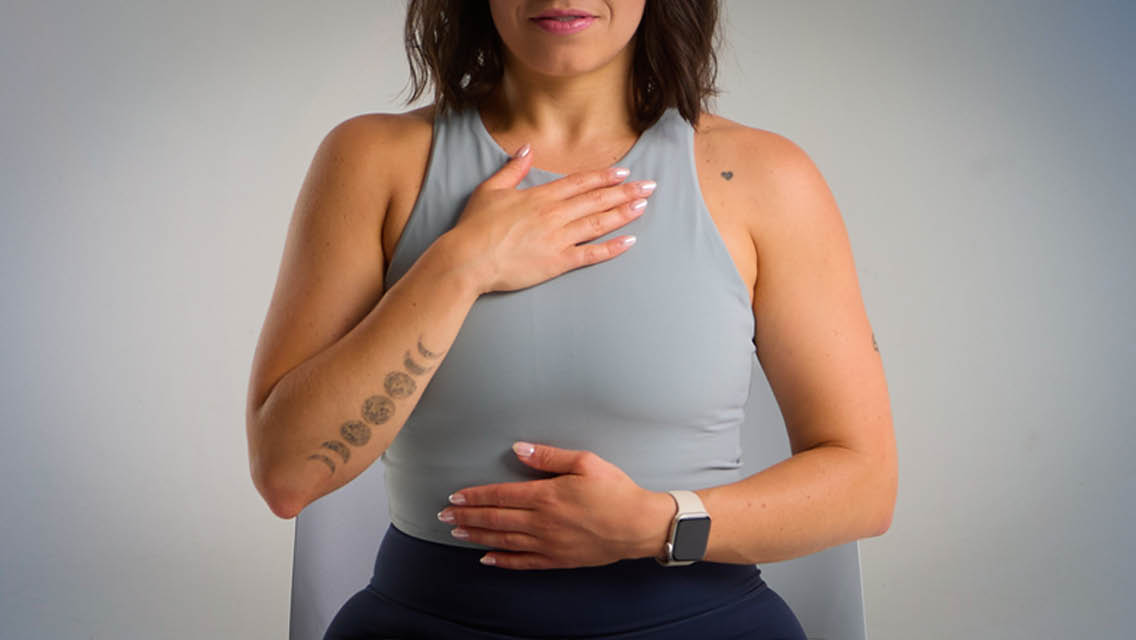Fitness efforts often revolve around extrinsic data points. We dutifully log sets, reps, and weights. Track miles, meters, and time under tension. Strive for perfect form, optimal alignment, and efficiency of movement. But a growing number of fitness professionals and exercisers are embracing a healing mind–body approach known as somatics, which shifts the focus from the outside in.
“Somatics describes dropping into the body and connecting with what you feel on the inside, emotionally and physically,” explains Emily Johnson, a holistic nurse, yoga teacher, and somatic coach.
Derived from the ancient Greek word for “body,” somatic means “of or relating to the body.” The term “somatics” is attributed to Thomas Hanna, PhD, a professor, philosopher, and author of the 1970 book Bodies in Revolt: A Primer in Somatic Thinking. Today, somatics represents a broad field that encourages practitioners to home in on their internal sensations, perceptions, and experiences.
A somatic framework has been applied to mental health services like therapy, particularly in the treatment of posttraumatic stress disorder (PTSD); bodywork like massage and acupressure; cultural healing and anti-racism modalities; and numerous physical-movement practices.
In 2023, “somatic workout” emerged as a top Google trend, and it has become a mainstay search term, with results promising a variety of health and fitness benefits from better sleep to weight loss.
But the goal of a somatic practice, experts argue, is embodiment — a healing state of being grounded, settled, and tuned in to the body.
“Somatic practices help individuals become more attuned to their body’s sensations, alignment, and movements,” explains Tory Schaefer, Life Time’s senior director of class education and yoga. “By emphasizing mindful attention, somatics can activate the parasympathetic nervous system, promoting relaxation and reducing stress. This can lead to lower levels of anxiety and an overall sense of calm.”
Somatics, adds Johnson, is “a way to relax, connect, heal, and find peace in yourself. It helps you get connected to your true inner compass so that you can have confidence in what you are experiencing, who you are, and what you want or need to do.”
She discovered the practice following a traumatic abdominal injury that, even after her physical injuries healed, caused her tremendous chronic pain and stress. “I was able to heal when I understood that my chronic pain was rooted in a fear of reinjury and a dysregulated nervous system,” she says. “Through somatics, I went from a state of being fearful, stressed, always in my head, and never in the moment, to now being in a state of peace.”
The quest for this peaceful state is a major driver behind the popularity of somatics and embodiment practices, says Jessie Syfko, ND, RYT, CSCS, FMS, Life Time’s vice president of group training and studio and creator of MB360, a mind–body group-training format.
“Our world is suffering with an abundance of mental health issues,” says Syfko. “The conversation [around mental health] is becoming more normalized, and we are getting better at understanding how much our body stores our unresolved emotional experiences. That has opened the opportunity for all the ways [we] can resolve tension [and] stress and improve our mental state. People are hungry for a better understanding of how to feel better.”
(Listen as Syfko explains more about this connection, the benefits it provides, how we can grow it, and the integral relationship it has to our fitness efforts at, “The Mind-Body Connection: Tapping in to Mindfulness Through Movement.”)
In Search of Sensation
Somatic movement is often described as synonymous with gentle movement practices, such as some forms of yoga and tai chi. But if intention and attention are lacking, those gentle movement practices are not somatic. And while somatic exercises are designed to be performed gently, the heightened focus that comes with noticing the body’s inner workings can sometimes feel uncomfortable.
So, what does a somatic exercise look like?
Most are slow and controlled, though they can take many forms.
Some practices, for example, may involve little to no physical movement. A seated or prone body scan to get in tune with sensations is a basic somatic practice, even if it’s not technically a physical exercise, says Johnson.
And, while not inherently somatic, yoga and tai chi are commonly cited as examples of movement disciplines with somatic potential because of their emphasis on awareness, breathwork, alignment, and controlled movement. Not all yoga teachers adhere to those internal practices, but Shaefer notes that “when a teacher can cue in a way that takes the student on an internal journey of self-discovery, it’s magical. It’s typically the little simple cues that blow my mind.”
Strength-training modalities are less recognized in the field of somatics but also provide an opportunity for somatic intention and exploration. “[Bodybuilders] have been doing somatic work since the invention of the gym,” says Mark Schneider, CSCS, a trauma-informed strength coach. Bodybuilding has somatic potential thanks to a strong emphasis on isolation and activation using the mind–muscle connection. (Curious about what trauma-informed movement is? Learn more at “How Movement Therapy Can Heal Traumatic Stress.”)
This wide range of practices illustrates that anything can be somatic if it brings your attention to your body. “You don’t have somatics without mindful awareness of physical sensation,” says Syfko.
To that end, some experiences, like balance work, isometrics, and learning something new, have somatic work built in, because they require you to dial in and pay attention. But, beyond the extreme of being forced to pay attention because of the possibility of falling over, for instance, intent will drive awareness.
“Because the body has so much capacity for sensation, you won’t feel it unless you’re looking for it,” says Schneider. “Feel your feet. Feel your breath. Feel into whatever feels safe in the moment.”
Healing Through Embodiment
To understand how somatics works, it’s important to understand that our bodies hold our life experiences. This is especially true of traumatic experiences, including those that are physical, psychological, vicarious, acute, chronic, personal, collective, and intergenerational.
Even people who cannot pinpoint a traumatic event or experience often live with unconscious, protective patterns formed by their past experiences. These patterns might manifest as anxiety, depression, hypervigilance, panic attacks, addiction, violence, or other mental health challenges; they can also present as chronic pain, limited mobility, sleep and digestion issues, or other physical symptoms too.
Notably, the conscious mind is not always able to access what needs to be processed, which is where healing through the body comes in. “We need to understand our body’s process of connection and settling,” writes therapist and somatic educator Resmaa Menakem, MSW, LICSW, SEP, in his book My Grandmother’s Hands.
“We need to slow ourselves down and learn to lean into uncertainty, rather than away from it. We need to ground ourselves, touch the pain or discomfort inside our trauma, and explore it — gently. This requires building a tolerance for bodily and emotional discomfort, and learning to stay present with — rather than trying to flee — that discomfort. …With practice, over time, this enables us to be more curious, more mindful, and less reflexive. Only then can growth and change occur.”
Menakem teaches that much of human behavior involves a part of the body he calls the “soul nerve.” More commonly known as the vagus nerve, it is “the unifying organ of the entire nervous system,” he writes.
“When your body feels relaxed, open, settled, and in sync with other bodies, that’s your soul nerve functioning. When it feels energized, vibrant, and full of life, that’s also your soul nerve. When it feels tight, constricted, and self-protective, that’s your soul nerve, too.”
In his book and courses, Menakem offers “soul-nerve training,” a series of simple somatic practices that includes humming, rocking, belly breathing, and chanting as ways to connect to the body and begin to explore the limits of your comfort zone.
The Benefits of Somatics
The potential benefits of seeking embodiment through somatic work are manifold, Schaefer says. Improved body awareness can lead to better posture and movement. Mindful movements activate the parasympathetic nervous system, promoting relaxation and reduced stress.
“Somatic exercises can focus on identifying and releasing chronic tension patterns in the body,” he explains, noting that this can help alleviate pain, improve mobility, and enhance overall physical comfort. “And many somatic practices incorporate breath awareness and control, leading to improved respiratory function and a greater sense of vitality.”
Additionally, by cultivating a mindful relationship with their bodies, somatics can “encourage individuals to stay present and enhance overall mindfulness in daily life,” he says.
Somatic coaches often emphasize that a consistent somatic practice can lead to a release of pain — physical or emotional, or both. But, experts urge, it’s important not to get distracted by chasing that release. “The intention is tuning in to the body, in the moment,” says Schneider. “Let the benefits unfold from there.
“Everyone can benefit [from a somatic practice]. It supports us in becoming less reactive, and when we are less reactive, we are more likely to let go of fears and/or frustrations that lead to unhealthy living in every way.”
That said, not everyone will benefit from practicing on their own. It is possible for some people to experience too much release without a trained instructor, and people experiencing acute levels of trauma would also want to seek professional advice as to how to engage in somatics, says Syfko.
“Somatics gets tricky for people who don’t understand what they’re feeling,” says Schneider. “Not being able to understand what you’re feeling is scary. Some people can easily rationalize it away, some can easily compartmentalize, and some people default to ruminating over it. Professional guidance can help them determine what that sensation means to them. Especially if you’re using somatics for mental health, it’s something that should at some point be guided by someone who can respect that aspect of it.”
Whether you’re practicing solo or with a guide, a sense of safety is a critical aspect of somatics.
“Getting into the body and feeling safe there — that is the work,” says Johnson, who advises titrating — or continuously monitoring and adjusting the balance — between areas of anxiety or tension and areas of safety or comfort to avoid overwhelm or the possibility of being retraumatized by whatever your body is holding onto.
“It can take time, so it’s important to do this work with compassion,” she says. “Remember, our patterns are there to protect us. They served a purpose at some point. But they are not personality traits. You can change by healing these conditioned patterns.”
Dropping In
The magic of somatics isn’t in any particular movement, movement pattern, or movement at all. It’s in building awareness and practicing the art of noticing what’s happening within our bodies.
Experts offer the following practices as entry points into somatic work. Think of them as invitations rather than as a strict set of instructions, and try not to stress about doing a practice “correctly.”
Think of them as invitations rather than as a strict set of instructions, and try not to stress about doing a practice “correctly.”
Rather, move slowly and focus on noticing the sensations within you. If any of these suggestions trigger extreme panic, fear, or pain in your body, stop right away. Before trying again, seek out a knowledgeable, trauma-informed guide with somatic training for support.
“Dropping into the body is different every time,” says Johnson. “And everybody’s journey into the body is so different. We heal slowly. It won’t all come up at once. It won’t all be healed at once. But what we’re feeling in the moment can show us the way.”
4/1 Segmented Breathing
“This simple breathing technique supports nervous-system regulation and builds more resilience and better coping mechanisms over time,” says Johnson. Practice it in the morning to prepare for your day, in the moment as stress and triggers come up, or at the end of the day.
“It’s OK if you can’t do this right away in the moment when feelings come up. Tell your body you will take care of it later to calm yourself down, and build trust by actually coming back and dropping into your body later on.”
Full Instructions
- Assume a comfortable seated position. Place one hand on your heart and one hand on your belly, and close your eyes, if that is comfortable. Check in with your body and how you are feeling.
- When you are ready, inhale through your nose in four equal sniffs.
- Without pausing after the fourth sniff, initiate a long exhale through your nose.
- Find a rhythm of four short inhales and one long exhale. (The exhalation will take approximately the same length of time as the four inhales.)
- Repeat the sequence five times, or more, as desired.
Body Scan
Johnson recommends body scans as a somatic exercise to help build awareness and practice self-regulation. “As you begin to notice sensations in your body, find neutral spots that feel good and safe. Know that you can always shift your attention back to these spots. Then, when you feel ready, you can begin to explore areas of tension and anxiety in the body, or go to a place of feeling you are being called to put your attention on. You’re not trying to tolerate suffering; don’t overwhelm yourself. It’s an exploration and a return to safety, always.”

Full Instructions
- Sit or lie down in a comfortable position.
- Deepen your breaths and close your eyes.
- Bring your attention to your feet. Notice how your toes feel, then your arches and your ankles.
- Slowly work up your body, mentally traveling up your legs, pelvis, torso, arms, neck, back of your head, ears, and face. Scan your body evenly and notice any feelings, emotions, or sensations that arise. Maybe you notice your heart beating or anger in your chest.
- As you scan, ask yourself what feels comfortable and what feels uncomfortable. Stay open and curious — there’s no need to change anything. If you are distracted by intrusive thoughts the practice is to drop back down into feeling the sensations again where you left off.
This is a simple practice just to get into the body through sensations and to increase body awareness. The more you feel, the more and more you will live in the body and be in tune with your inner compass.
Slow Rocking
In My Grandmother’s Hands, Menakem offers slow rocking — a soothing behavior that many small children intuitively do and that parents do with their babies — as a simple somatic exercise that can help the body settle and ground. “[My grandmother] frequently comforted herself by rocking, both forward and backward and from side to side,” he writes. “When I would watch her rock, it never looked nervous or neurotic. Instead, it felt like a sacred ritual, imbued with meaning and purpose.”
Full Instructions
- Assume a comfortable seated or standing position and take a few slow, deep breaths.
- Keeping your eyes open, slowly rock your upper body from side to side, or forward and back. If you’d like, play or hum a slow, soothing tune and rock to its beat.
- Experiment with standing versus sitting; with rocking from side to side versus forward and back; with a range of different (but always slow) speeds; and with sitting in a variety of positions.
- Continue for one to two minutes, or longer if you’d like.
- Come to a stop and notice what your body is experiencing.
Arm Swings
“I love cues that speak to feeling into the space we occupy to help release attachment and tension,” says Syfko. One of her favorite ways to take up more space is through arm swings, which can be performed while sitting or standing.
Full Instructions
- From a neutral seated or standing position, place your feet hip width apart and feel your feet on the earth. Bring your arms to your sides and feel the ground supporting you.
- Inhale as you lift your arms over your head.
- As you exhale, bend your upper body forward, hinging at your hips, and let your arms release to swing forward, down, and behind you. Be open to any sighs or other vocalizations that release on the exhale.
- Repeat, continuing in this manner — inhaling to raise your arms overhead and exhaling to release your arms forward, down, and behind you — at your own pace for two minutes.
Tabletop
Grand movements aren’t a requirement for somatic work. In fact, says Schaefer, subtle changes in alignment, pressure, and resistance can press you “to look at your practice in a whole new light.”
Take, for example, the following cues to try the next time it’s convenient. “It’s no longer about doing poses but the deep, profound connection that’s inside and then around us every day.”

Full Instructions
- Assume a tabletop position on your hands and knees — wrists under your shoulders, knees under your hips, and neck neutral.
- Stay here. Take time to find your breath. Slowly massage each finger into the mat or floor.
- Observe how that simple movement plays a role in what happens in the wrists all the way up through the rotator cuff.
Foot Clock
Schneider recommends the following single-leg exercise, which combines the extreme somatic sensations of balance and isometrics. “It requires hyperfocus to not fall over,” he says.
Full Instructions
- Begin standing, with both feet grounded on the floor. Notice the distribution of weight across both feet, then shift your weight onto your left side. Bring your awareness to your left foot; feel the heel and the ball of your foot. Use your right foot as a kickstand until you find your balance.
- From here, your left leg will act as the stable center of the clock while your right leg will be the moving hand of the clock: Keeping your left foot planted, extend your right leg and reach your right foot forward to tap the spot that would be 12 o’clock with your toes. Raise the foot and reach to tap 1 o’clock, then 2, then 3, and so on to 6 o’clock behind you. Remember to keep your weight on your left leg; don’t lean into the right foot as you tap. Move slowly and with control, paying attention to your breath and the sensations in your body.
- Switch legs and repeat with the right foot planted, left toes reaching for 12, 11, 10, and so forth to 6 o’clock.
Biceps Curl
A central tenet of bodybuilding, explains Schneider, is the mind–muscle connection, which involves concentrating on muscles contracting and stretching through different parts of a movement. “This bodybuilding principle emphasizes internal focus and what you’re feeling inside the body” as a tool to boost muscle activation.
Full Instructions
- Begin standing or sitting, holding a dumbbell in one hand with your arm fully extended at your side.
- Keeping your upper arm and elbow close to your body and your shoulders relaxed, bend your elbow to curl the dumbbell up.
- Bring your focus to the biceps muscle, feeling into its different parts. Pay attention to the contraction of the muscle as you curl the weight up; notice the feel of the muscle stretching as you extend your arm to lower the weight.
- Repeat the movement, turning your arm slightly to explore different positions. Try turning your palms in to face each other, to face your body, or to face completely away from you. Notice how the sensations in the muscle change with each position.
- Repeat with the opposite arm.





